

Making Sense of Documentary Photography. A picture may be worth a thousand words, but you need to know how to analyze the picture to gain any understanding of it at all.
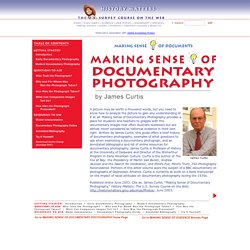
Making Sense of Documentary Photography provides a place for students and teachers to grapple with the documentary images that often illustrate textbooks but are almost never considered as historical evidence in their own right. Written by James Curtis, this guide offers a brief history of documentary photography, examples of what questions to ask when examining a documentary photograph, and an annotated bibliography and list of online resources for documentary photography. James Curtis is Professor of History at the University of Delaware and Director of the Winterthur Program in Early American Culture. Curtis is the author of The Fox at Bay: the Presidency of Martin Van Buren, Andrew Jackson and the Search for Vindication, and Mind's Eye, Mind's Truth, FSA Photography Reconsidered.
Published online June 2003. History Lessons. The Reading Like a Historian curriculum engages students in historical inquiry.
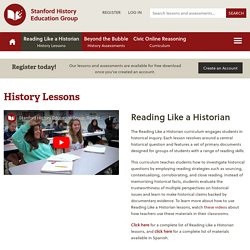
Each lesson revolves around a central historical question and features a set of primary documents designed for groups of students with a range of reading skills. This curriculum teaches students how to investigate historical questions by employing reading strategies such as sourcing, contextualizing, corroborating, and close reading. Instead of memorizing historical facts, students evaluate the trustworthiness of multiple perspectives on historical issues and learn to make historical claims backed by documentary evidence. Why Study History? Civic Online Reasoning.
Appendices. Many primary sources are not in written form and trying to describe them in an essay is difficult.
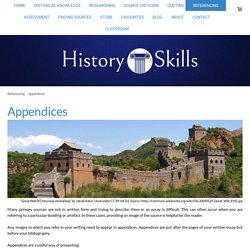
This can often occur when you are referring to a particular building or artefact. In these cases, providing an image of the source is helpful for the reader. Contradiction. When you are analysing a source, it is helpful to compare what information it provides when compared with other sources.
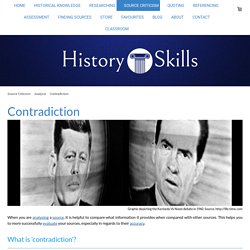
This helps you to more successfully evaluate your sources, especially in regards to their accuracy. In order to identify information that is disagreed upon by two different sources, following these steps: Read the first source and summarise the key points of historical information they provide. Using direct and indirect quotes helps with this. Read the second source and summarise the key points of historical information they provide.
Source Creator. The first step in creating an effective analysis of a source is to find out who created it.
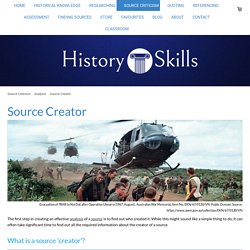
While this might sound like a simple thing to do, it can often take significant time to find out all the required information about the creator of a source. When we talk about the 'creator' of a source, we want to know who originally made it. Different kinds of sources usually have a particular kind of creator. For example: Depending upon the type of sources, you need to look in different places to find out who the creator was. Books: usually listed on the front cover Websites: usually listed at the very bottom of an internet page Academic Journals: usually listed on the very first page of the document. Significance. Things are often considered to be important if they do something new, which had never been seen before.
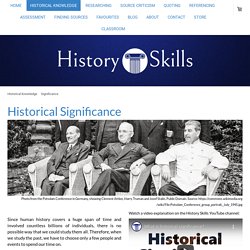
The word ‘novelty’ means “the quality of being new, original, or unusual“. This is often the way that people from the past measured the significance of people and events from their own time. When an event or person was mentioned by the people alive at the time, it usually shows us that they considered them to be particularly remarkable. Therefore, looking for what was novel, or “new”, about a person, event, location or idea, is often a good way to decide why it is significant.
Things from the past can suddenly be considered significant because people have realised that they are applicable to something happening in the present. Things are often considered to be important if they do something new, which had never been seen before. Things from the past can suddenly be considered significant because people have realised that they are applicable to something happening in the present.
Comprehension. Comprehension is the easiest of the critical thinking skills.
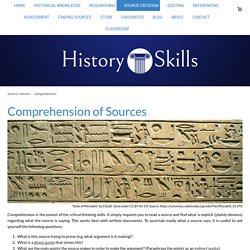
It simply requires you to read a source and find what is explicit (plainly obvious) regarding what the source is saying. This works best with written documents. Rationale. When you are doing a research assessment piece in History, you’ll often be asked to write a rationale.
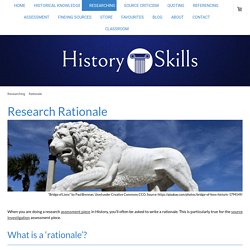
This is particularly true for the source investigation assessment piece. (37) Out of Context Joffrey Baratheon. Time of Creation. When analysing a source, you need to be aware of when it was made.
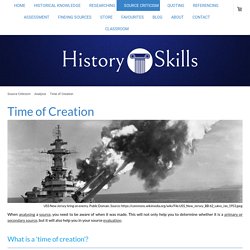
This will not only help you to determine whether it is a primary or secondary source, but it will also help you in your source evaluation. The 'time of creation' is the date when the source was originally made. For some sources, particularly secondary, you can find out the exact year it was published. Written Essays. The biggest assessment task you will be required to complete is a written research essay which develops an argument and uses a range of sources.
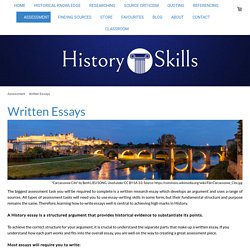
All types of assessment tasks will need you to use essay-writing skills in some form, but their fundamental structure and purpose remains the same. Therefore, learning how to write essays well is central to achieving high marks in History. A History essay is a structured argument that provides historical evidence to substantiate its points. To achieve the correct structure for your argument, it is crucial to understand the separate parts that make up a written essay. If you understand how each part works and fits into the overall essay, you are well on the way to creating a great assessment piece. 1. Key Question. At the beginning of the research process, you need to be clear about what you are trying to discover as a result of your research.
To create a focus to drive your research, you are required to create a Key Inquiry Question. A Key Inquiry Question is the question that your research is aiming to answer. 3. Sub-questions. Once you have become familiar with your topic through your background research, you can begin to think about how to approach answering your Key Inquiry Question.
However, the Key Inquiry Question is usually too broad to answer at this early juncture. Therefore, you need to break your Key Inquiry Question into smaller questions (called 'sub-questions') in order to answer it sufficiently. A good Key Inquiry Question can easily be divided into three separate parts which can be turned into sub-questions. Based upon good background research, you should be able to identify the three divisions of your Key Inquiry Question. For example: If your Key Inquiry Question was: Why did Martin Luther King believe that social problems could be fixed through non-violent means? Critical Summary. How to Count Centuries in History. Change and Continuity. History is the study of change over time. All sorts of things change over time: empires, languages, ideas, technology, attitudes, etc.
Historians study different types of events through time and group these events based upon topics or themes. Breaking historical events up based upon categories makes it easier for people to identify changes and study the effects on people over time. Some general categories of events include: Political - To do with war, power, governments and legal rights Economic - How people earn and spend money Social - The everyday lives of people at work and home Technology - To do with developments in technology and medicine ‘Change’ refers to something that is obviously different from what occurred previously.
Teaching repatriation issues — Ancient History School. Photographs. Interpreting a visual source, like a photograph, is very different to interpreting words on a page, which is the case with written sources. Therefore, you need to develop a different set of skills. Photographs are very useful types of primary sources. They provide a rare glimpse of a particular second in time, which will never again be repeated. This is especially true for events that occurred before the development of television or digital technologies.
Many people assume that photographs are unbiased, accurate records of historical events. If you want to gain a further appreciation of how different photographers can effect what an audience sees in an image, watch the clip below: When people take a photograph, they make decisions about what to show in, or leave out of, the picture. Historical Source Criticism. Essay Exams. Source Evaluation - Usefulness. Contestability. Contestability is a source evaluation skill which requires you to acknowledge that different historical interpretations can be supported by the surviving evidence. Contestability is the idea that two separate sources can draw different conclusions about a historical person, concept or event. Contestability most commonly occurs between two modern sources, typically academics, who have studied the surviving material in detail, but hold two different interpretations of the past.
8. Draft Writing. Once your topic sentences and hypothesis are completed, you can start writing your essay, beginning with your first draft. Chronology. The very first step in grasping History is to understand chronology. Quoting. Political Cartoons. A Guide to Teaching Essay Structure. 6. Topic Sentences. Accuracy. Recommendations. 1. Key Question. Source Analysis - Perspective. Relevance. Time of Creation. Source Creator. Written Essays. Corroboration. 3. Sub-questions. 9. Final Draft. Causes and Consequences. Why Study History - QHTA. Curriculum Pathways® Writing on History at Queens College. Propaganda Posters. Political Cartoons. Purpose. Solving the history textbook conundrum: a five-point manifesto. Why I Teach Journalism in My History Classes. History in Three Dimensions. The Historian's Hut: Did You Know?: Most Speeches From Ancient History Books Are Fake.
The Art of the Paragraph – Robert Peal. Written Essays - History Skills. Writing Essays in History. Reading Like A Historian. Working with historians. Assessment - History Skills. 9. Final Draft - History Skills. Causes and Consequences - History Skills. Why Study History? Essay Exams - History Skills. Civilization ("Harajuku Girls" by Gwen Stefani) History Source Skills. Finding Sources - History Skills. Indirect Quotes - History Skills. Perspective - History Skills. Constructive (Source) Criticism - History Skills. Historical Moments Photographed Just After The Big Event. The Student's Friend World History & Geography. How Young Is History? Historical Thinking Matters: Students.
Home.